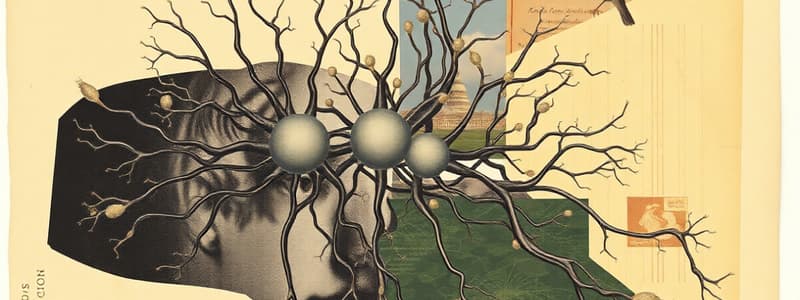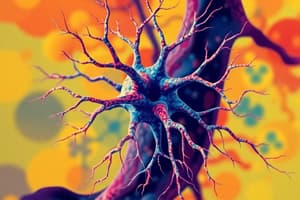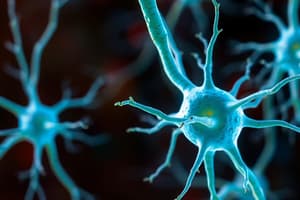Podcast
Questions and Answers
Which of the following is a primary function of animal nervous systems?
Which of the following is a primary function of animal nervous systems?
- Regulating body temperature through fur density.
- Producing reproductive cells.
- Coordinating movement. (correct)
- Synthesizing essential nutrients.
Which type of neuron is responsible for transmitting information about an animal's environment or its internal physiological condition?
Which type of neuron is responsible for transmitting information about an animal's environment or its internal physiological condition?
- Neuroglial cells
- Motor neurons
- Sensory neurons (correct)
- Interneurons
What is the main role of interneurons in the nervous system?
What is the main role of interneurons in the nervous system?
- Transmitting signals directly to muscles causing movement.
- Receiving sensory input from the external environment.
- Maintaining a stable internal state through hormone secretion.
- Processing received information and transmitting it to different body regions. (correct)
Which of the following best describes the function of motor neurons?
Which of the following best describes the function of motor neurons?
What is the primary role of the nervous system in maintaining homeostasis?
What is the primary role of the nervous system in maintaining homeostasis?
Which of the following represents the correct order of increasing complexity in nervous systems?
Which of the following represents the correct order of increasing complexity in nervous systems?
Which of the following best describes the nervous system found in sea anemones?
Which of the following best describes the nervous system found in sea anemones?
What structural feature is a key characteristic of vertebrate nervous systems, distinguishing them from simpler invertebrates such as sea anemones or flatworms?
What structural feature is a key characteristic of vertebrate nervous systems, distinguishing them from simpler invertebrates such as sea anemones or flatworms?
Which components are common to all neuron types?
Which components are common to all neuron types?
What is the primary function of glial cells in the nervous system?
What is the primary function of glial cells in the nervous system?
Astrocytes contribute to the blood-brain barrier, which primarily functions to:
Astrocytes contribute to the blood-brain barrier, which primarily functions to:
Why is the resting membrane potential of a neuron negative?
Why is the resting membrane potential of a neuron negative?
What role does the Na+-K+ pump play in maintaining the resting membrane potential of a neuron?
What role does the Na+-K+ pump play in maintaining the resting membrane potential of a neuron?
During an action potential, what causes the rapid depolarization of the neuron's membrane?
During an action potential, what causes the rapid depolarization of the neuron's membrane?
What is the role of voltage-gated potassium channels in an action potential?
What is the role of voltage-gated potassium channels in an action potential?
What occurs during the refractory period of an action potential?
What occurs during the refractory period of an action potential?
How do neurons typically code the intensity of a stimulus?
How do neurons typically code the intensity of a stimulus?
What is the role of myelin in the propagation of action potentials?
What is the role of myelin in the propagation of action potentials?
What is the importance of nodes of Ranvier in myelinated axons?
What is the importance of nodes of Ranvier in myelinated axons?
What type of channels open in the axon terminal as a result of depolarization during synaptic transmission?
What type of channels open in the axon terminal as a result of depolarization during synaptic transmission?
What is the direct effect of neurotransmitters binding to receptors on the postsynaptic cell?
What is the direct effect of neurotransmitters binding to receptors on the postsynaptic cell?
What is the difference between excitatory and inhibitory signals in neuronal communication?
What is the difference between excitatory and inhibitory signals in neuronal communication?
What is the result of spatial summation?
What is the result of spatial summation?
What are the two main components of the peripheral nervous system?
What are the two main components of the peripheral nervous system?
Which division of the peripheral nervous system is responsible for conscious reactions?
Which division of the peripheral nervous system is responsible for conscious reactions?
Which of the following physiological responses is associated with the parasympathetic division of the autonomic nervous system?
Which of the following physiological responses is associated with the parasympathetic division of the autonomic nervous system?
What is the function of the sympathetic ganglia?
What is the function of the sympathetic ganglia?
What is the knee-extension reflex?
What is the knee-extension reflex?
How does the sensory transduction convert a stimulus?
How does the sensory transduction convert a stimulus?
What best describes chemoreceptors?
What best describes chemoreceptors?
Mechanoreceptors are responsible for detecting:
Mechanoreceptors are responsible for detecting:
What is pressure detected by in invertebrates and vertebrates?
What is pressure detected by in invertebrates and vertebrates?
Which of the following structures is responsible for transducing sound vibrations into electrical signals in the human ear?
Which of the following structures is responsible for transducing sound vibrations into electrical signals in the human ear?
What best describes the role of opsin?
What best describes the role of opsin?
The compound eye of insects is composed of:
The compound eye of insects is composed of:
Which of the following statements best describes the function of cone cells in color vision?
Which of the following statements best describes the function of cone cells in color vision?
During brain development, what are the three major regions that the brain develops into?
During brain development, what are the three major regions that the brain develops into?
Which brain region is most associated with long-term memory formation?
Which brain region is most associated with long-term memory formation?
What is a key function the limbic system drives?
What is a key function the limbic system drives?
What is the surface of the brain highly folded?
What is the surface of the brain highly folded?
What is the primary function of the motor cortex?
What is the primary function of the motor cortex?
Human brains are able to process and integrate complex sources of what?
Human brains are able to process and integrate complex sources of what?
Flashcards
Nervous System Function
Nervous System Function
Animal nervous systems allow organisms to sense and respond to the environment and regulate internal functions.
Nervous System
Nervous System
A network of interconnected nerve cells (neurons) that facilitates rapid communication.
Sensory Neurons
Sensory Neurons
Receives and transmits information about an animal's environment or internal state.
Interneurons
Interneurons
Signup and view all the flashcards
Motor Neurons
Motor Neurons
Signup and view all the flashcards
Homeostasis
Homeostasis
Signup and view all the flashcards
Dendrites
Dendrites
Signup and view all the flashcards
Axons
Axons
Signup and view all the flashcards
Glial Cells
Glial Cells
Signup and view all the flashcards
Astrocytes
Astrocytes
Signup and view all the flashcards
Electrically excitable membranes
Electrically excitable membranes
Signup and view all the flashcards
Membrane Potential
Membrane Potential
Signup and view all the flashcards
Resting Membrane Potential
Resting Membrane Potential
Signup and view all the flashcards
Action potential
Action potential
Signup and view all the flashcards
Refractory Period
Refractory Period
Signup and view all the flashcards
Information Coding
Information Coding
Signup and view all the flashcards
Propagation of Action Potentials
Propagation of Action Potentials
Signup and view all the flashcards
Saltatory Conduction
Saltatory Conduction
Signup and view all the flashcards
Chemical Synapse
Chemical Synapse
Signup and view all the flashcards
Excitatory Postsynaptic Potential (EPSP)
Excitatory Postsynaptic Potential (EPSP)
Signup and view all the flashcards
Integration of information
Integration of information
Signup and view all the flashcards
Peripheral nervous system
Peripheral nervous system
Signup and view all the flashcards
Parasympathetic Division
Parasympathetic Division
Signup and view all the flashcards
Sympathetic Division
Sympathetic Division
Signup and view all the flashcards
Simple reflex circuits
Simple reflex circuits
Signup and view all the flashcards
Sensory receptors
Sensory receptors
Signup and view all the flashcards
Chemoreceptors
Chemoreceptors
Signup and view all the flashcards
Mechanoreceptors
Mechanoreceptors
Signup and view all the flashcards
opsin
opsin
Signup and view all the flashcards
Limbic system
Limbic system
Signup and view all the flashcards
Cerebral Cortex
Cerebral Cortex
Signup and view all the flashcards
Study Notes
Nervous System Function and Evolution
- Animal nervous systems are designed for organisms to perceive and react to their surroundings
- They facilitate movement coordination and control the body's internal operations
- A nervous system comprises interconnected nerve cells or neurons
Types of Nerve Cells
- Sensory neurons receive and relay data concerning the animal's environment or its internal state
- Interneurons handle incoming information and send it to various body parts
- They communicate with motor neurons to produce an appropriate response, for example, a ganglion
- Motor neurons induce movement and regulate internal physiology, such as constricting blood vessels or digestive contractions
- The primary purpose of the nervous system is to maintain a stable internal environment, known as homeostasis
Nervous System Complexity
- Nervous systems vary from simple to complex, aligning with the complexity of the organism
- A brain is a defining trait in vertebrate nervous systems
Neuron Organization
- Neurons consist of dendrites that gather signals, and axons that transmit signals
- Signals can be electrical
Glial Cells
- Glial cells serve as a key support system for neurons, outnumbering the neurons in the human brain
- Glial cells provide nutrition and physical support to neurons
- Astrocytes, a type of glial cell, support blood vessels in the brain and maintain the blood-brain barrier against pathogens and toxins
Electrically Excitable Cells
- Neurons possess electrically excitable membranes that facilitate information transfer
- The number of charged ions differs inside and outside the cell
- A resting neuron has more negative ions inside, resulting in a negative charge relative to the outside
- The membrane potential refers to this charge difference
Neuron Resting Membrane Potential
- Resting potential is negative, determined by potassium ions moving out of the cell
- The resting potential of a neuron is negative and depends on movement of K+ ions out of the cell
- The Na+-K+ pump moves Na+ ions out and K+ ions into the cell using ATP
Action Potential
- Neurons communicate via action potentials
- Voltage-gated Na+ channels open and Na+ ions enter the cell, causing a positive spike in the membrane potential
- K+ channels open more slowly, allowing fewer K+ ions to leave the cell
- As the voltage rises to +40mV, Na+ channels close and voltage-gated K+ channels remain open
- This allows K+ ions to leave the cell, causing the membrane potential to become more negative
- The membrane returns to resting state, as excess K+ ions are returned to the cell, assisted by Na+-K+ pumps
- An overshoot of K+ ions leaving the cell causes hyperpolarization, causing a refractory period where the nerve cannot fire another action potential
Information Coding
- Neurons code information by altering the rate and timing of action potentials
- Higher firing frequency indicates a stronger stimulus
Propagation of Action Potentials
- Neurons transmit action potentials by opening and closing adjacent Na+ and K+ ion channels
Saltatory Conduction
- Myelination insulates axons for faster action potential conduction
Synapses
- Neurons communicate with other neurons or muscle cells by releasing neurotransmitters at a synapse
- Synaptic transmission starts with action potential conduction to the axon terminal
- Axon terminal depolarization opens voltage-gated Ca2+ channels
- Vesicles merge with the presynaptic membrane, releasing neurotransmitters into the synaptic cleft
- Neurotransmitters bind receptors on the postsynaptic cell, causing a change in membrane potential
Neuronal Signals
- Neurotransmitter binding opens ligand-gated Na+ channels, with more Na+ ions entering the cell
- This makes the membrane potential more positive, resulting in an excitatory postsynaptic potential (EPSP)
- Neurotransmitter binding opens ligand-gated Na+ or Cl- channels, with more Na+ ions existing or more Cl- ions entering the cell
- This makes the membrane potential hyperpolarized, resulting in an inhibitory postsynaptic potential (IPSP)
- Neurons integrate information from multiple communicating neurons
Summation of Postsynaptic Potentials
- EPSPs widely spaced in time do not trigger an action potential.
- Multiple EPSPs arriving rapidly at a single synapse can initiate an action potential
- Single EPSPs reaching multiple synapses can initiate an action potential
- An EPSP and an IPSP can cancel each other out, preventing an action potential
Nervous System Organization
- Nervous systems in animals are organized into central and peripheral components
- Nerves serve as communication lines between these components
Peripheral Nervous System (PNS)
- Vertebrate peripheral nervous system is divided into somatic and autonomic components
- The somatic system has sensory neurons responding to external stimuli and motor neurons synapsing with voluntary muscles
- The autonomic system features sensory and motor nerves, generally operating without conscious awareness
Autonomic Nervous System
- Involuntary or autonomic systems control internal body functions
- Parasympathetic division facilitates rest and digest activities, like constricting pupils and slowing heart rate
- Sympathetic division manages fight or flight responses, such as dilating pupils and accelerating heart rate
Reflex Circuits
- Simple reflex circuits allow quick responses to stimuli
- The knee-extension reflex employs a sensory neuron, single synapse, and motor neuron
- Reflex circuits bypass the brain
Sensory Receptor Cells
- Sensory receptor cells detect several stimuli
- Sensory transduction turns a stimulus into an electrical impulse
Sensory Receptors
- Chemoreceptors respond to chemical stimuli, underlying smell(olfaction) and taste(gustation)
- Mechanoreceptors detect physical forces for motion and gravity
- Invertebrates use statocyst organs and vertebrates use vestibular systems of semicircular canals and otolith organs
- Electromagnetic receptors, like opsin proteins, sense light, using light-sensitive pigments
- Invertebrates use eye cups, insects(housefly) use compound eyes, and humans use single-lens eyes
Color Vision
- Color vision uses photoreceptor cells with visual pigments sensitive to different light wavelengths
- Cone cells have color-sensitive pigments versus rod cells being sensitive to light in general
Three Major Brain Regions
- The brain develops in three regions: hindbrain, midbrain, and forebrain
- The forebrain develops into the cerebral cortex in humans
- Midbrain forms part of the brainstem
- Hindbrain includes the pons and medulla, as well as the cerebellum
Limbic System
- Limbic system governs physiological drives, instincts, emotions, and motivation with interactions in the midbrain
- It assists in long term memory with the hippocampus
Cerebral Cortex
- The cerebral cortex is organized with grey and white matter
- The surface of the brain is highly folded, increasing the surface area of the cortex, where neuron cell bodies are located
- Organized into frontal, parietal, occipital, and temporal lobes, as well as the cerebelum, and brainstem
Somatosensory Cortices
- Located behind the frontal lobes, the somatic cortex handles touch and spatial awareness
- Located behind the central sulcus in the frontal lobes, the motor cortex controls skeletal muscle movements
Topographic Maps
- The brain contains topographic maps of what part of the body is controlled by which parts of the brain
Memory
- The hippocampus converts reinforced short-term memories to long-term memories
- Stimulation of synapses in a circuit helps convert it to a long-term memory
- Human brains can process complex information, solve problems, and store memories
Studying That Suits You
Use AI to generate personalized quizzes and flashcards to suit your learning preferences.




